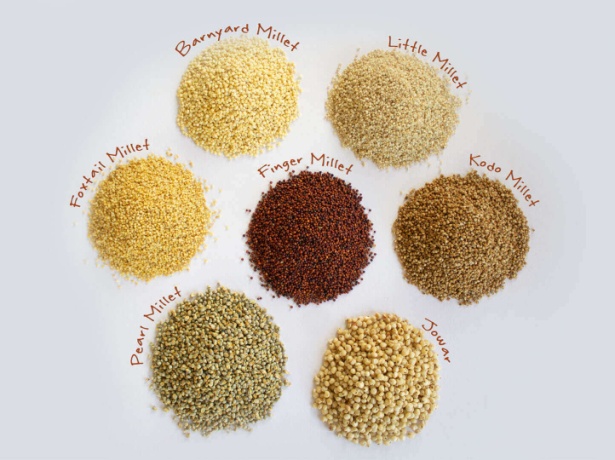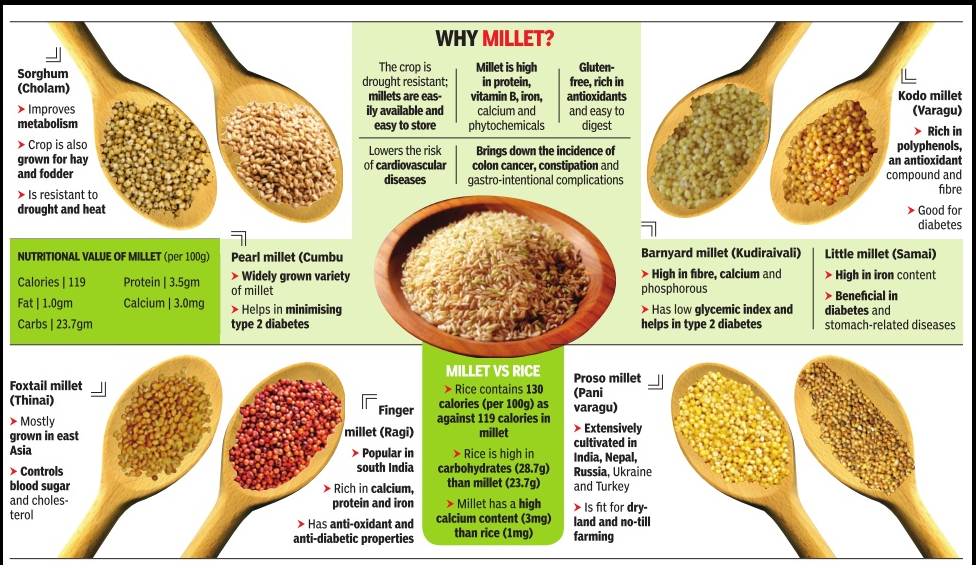Description

Disclaimer: Copyright infringement not intended.
Context
- NITI Aayog has entered into an agreement with United Nations World Food Program (WFP) to address issues related to inclusion of millets in government programmes.
Aim
- A more diversified food basket under its free food distribution programme with focus on coarse grains and millets.
- The focus will be on mainstreaming millets and strengthening of climate resilient agriculture for enhanced food and nutrition security in India.
- The partnership focuses on mainstreaming millets and supporting India in taking the lead globally in knowledge exchange.
- Further, the partnership will aim at building resilient livelihoods for small-holder farmers and adaptation capacities to climate change and transforming food systems.
Millets
- Millets are cereal crops with high nutritive value and categorized as small-seeded grasses.
- The key varieties of millets include Sorghum, Pearl Millet, Ragi, Small Millet, Foxtail Millet, Barnyard Millet, Kodo Millet and others.
- Major producers include Rajasthan, Andhra Pradesh, Telangana, Karnataka, Tamil Nadu, Maharashtra, Gujarat and Haryana.
- High in dietary fibre, nutri-cereals are a powerhouse of nutrients including iron, folate, calcium, zinc, magnesium, phosphorous, copper, vitamins and antioxidants.
- There is need to focus on the production of millets, also now known as “nutri-cereals” examples of nutri-cereals like jowar, bajra and ragi.
- Government is incentivising the production of nutri-cereals to increase the intake of diverse and nutritious diets, improve their availability in markets and bring benefits to small and medium farmers, who are the main cultivators of coarse grains.
- United Nations has declared the year 2023 as the International Year of Millets and preparations are being made to celebrate the International Year of Millets at the global level.

Efforts made: A multi-pronged strategy of the Government
- First strategy from a consumption and trade point of view was tore-brand coarse cereals/millets as nutri-cereals. Till 2018-19, millet production was extended to over 14 states.
- The government had observed 2018 as a year of millets to encourage and promote millet production in India and declared 2023 as the International Year of Millets, in line with the United Nations General Assembly resolution.
- Second, the government hiked the MSP of nutri-cereals,which came as a big price incentive for farmers. As we compare the data on MSPs for food crops from 2014-15 against 2020, we see that the MSP for ragi has jumped a whopping 113 per cent, followed by bajra and jowar at 72 per cent and 71 per cent respectively. MSPs have been calculated so that the farmer is ensured at least a 50 per cent return on their cost of production.
- Third, to provide a steady market for the produce, the government included millets in the public distribution system.
- Fourth, the Ministry of Agriculture & Farmers’ Welfare is running a Rs 600-crore scheme to increase the area, production and yield of nutri-cereals.
- With a goal to match the cultivation of nutri-cereals with local topography and natural resources, the government is encouraging farmers to align their local cropping patterns to India’s diverse 127 agro-climatic zones.
- Provision of seed kits and inputs to farmers, building value chains through Farmer Producer Organisations and supporting the marketability of nutri-cerealsare some of the key interventions that have been put in place.
- And finally, the Ministry of Women and Child Development has been working at the intersection of agriculture and nutrition by setting up nutri-gardens, promoting research on the inter-linkages between crop diversityand dietary diversity and running a behaviour change campaign to generate consumer demand for nutri-cereals.
Final Thought
- Under the distribution system, it is time that we shift the focus of food distribution programmes from ‘calories fundamentalism’ to providing a more diversified food basket, including coarse grains and millets to improve the nutritional status of pre-school children and women of reproductive age.
- In the next phase, it’s important to scale-up of millet mainstreaming through knowledge sharing and intense engagement with select states while they will leverage India’s expertise to support developing countries for millet mainstreaming and work on building capacities for climate resilient and adaptive livelihood practices.
- India is rightly focusing on capacity building in research, teaching, policy-making, trade and farming of nutritious cereals, which will benefit the farmers while conserving the amazing diversity available in this group of crops.
- As the government sets to achieve its agenda of a malnutrition-free India and doubling of farmers’ incomes, the promotion of the production and consumption of nutri-cereals is a policy shift in the right direction.
Read more at:
https://economictimes.indiatimes.com/news/economy/agriculture/niti-aayog-enters-into-agreement-with-un-wfp-to-diversify-food-basket-in-programmes/articleshow/88409584.cms?utm_source=contentofinterest&utm_medium=text&utm_campaign=cppst












